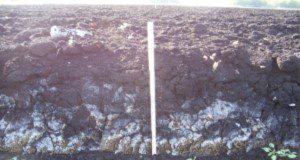This 4-page major revision, a publication of the UF/IFAS Department of Soil and Water Sciences, highlights the current status of Histosols within the Everglades Agricultural Area in southern Florida. Over the last century, soils within the region have gradually been lost via oxidation, a process commonly referred to as soil subsidence. The rate of subsidence is gradually declining, due to factors such as increased mineral content in soil, humification, and water management (maintenance of higher water tables). Best Management Practices and crop rotation help slow down the rate of oxidation and promote soil sustainability within the region. Written by Jehangir H. Bhadha, Alan L. Wright, and George H. Snyder.
https://edis.ifas.ufl.edu/ss523
Tag: George H. Snyder
SL311/SS523 Soil Subsidence in the Everglades Agricultural Area
SL311, a 3-page illustrated fact sheet by Alan L. Wright and George H. Snyder, describes the soils in the agricultural region in Florida south of Lake Okeechobee growing primarily sugarcane and winter vegetables, and addresses how the soils are changing with time. Includes references. Published by the UF Department of Soil and Water Science, November 2009.
http://edis.ifas.ufl.edu/ss523
